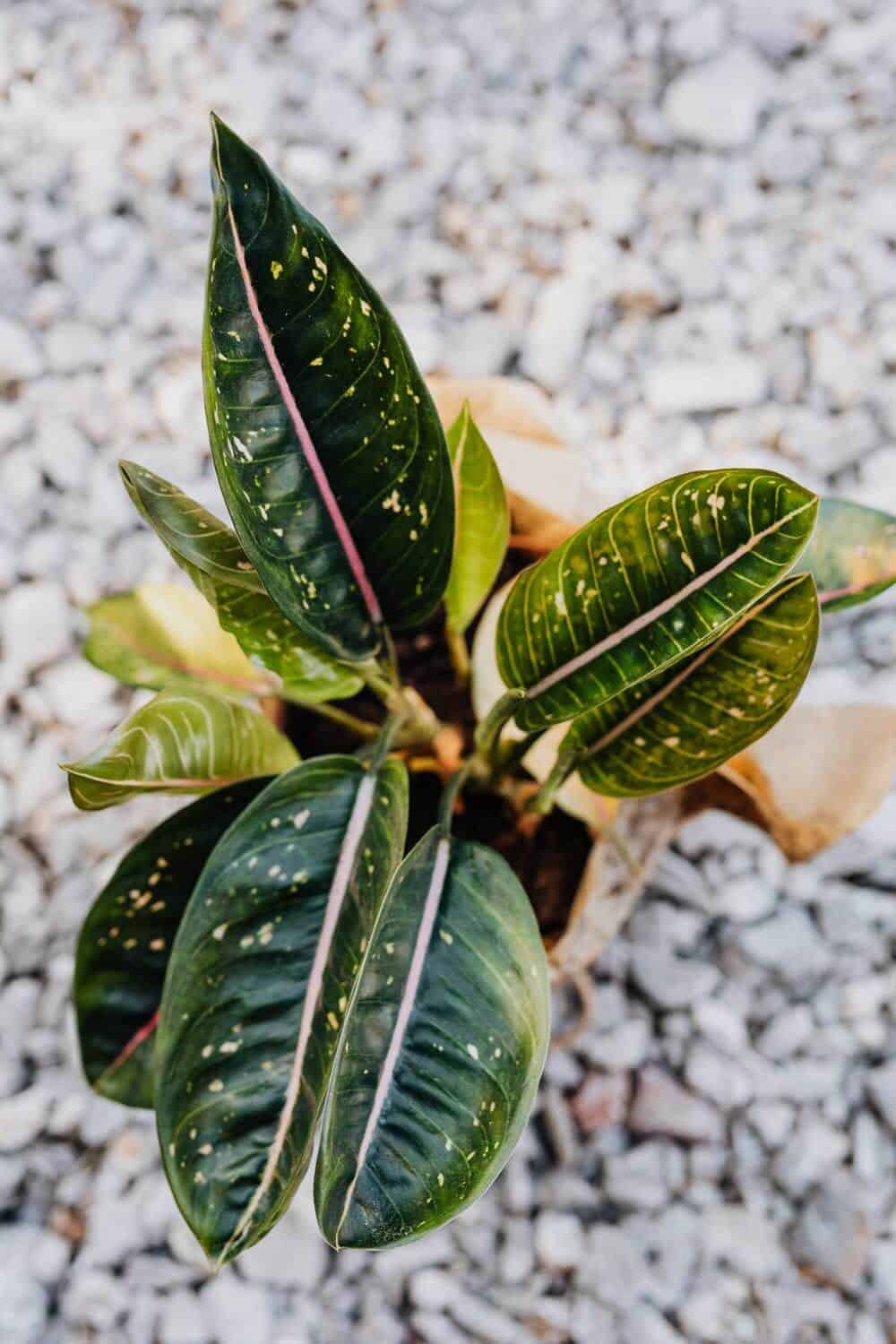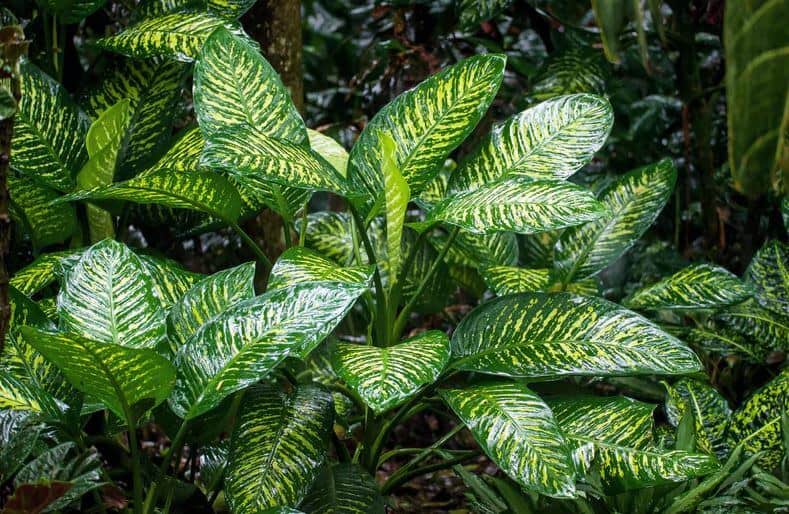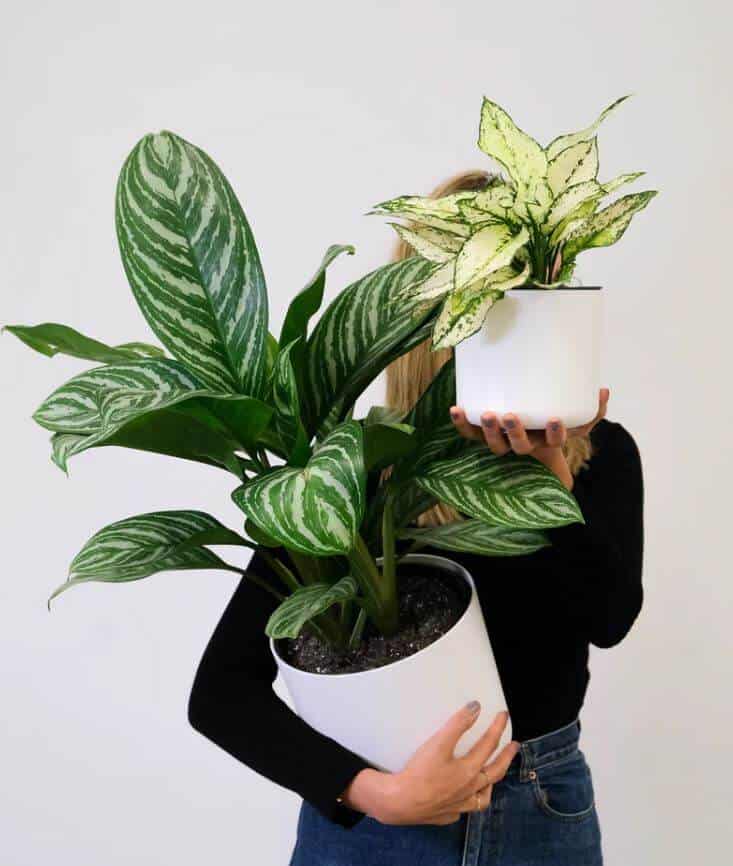Last Updated on February 13, 2023 by a Friendly Gardener
Botanically known as the Aglaonema commutatum this decorative houseplant is a native of Asia. Commonly referred to as the Chinese Evergreen it supposedly brings good luck. Transported to the West in 1885 it is now exceptionally popular as a houseplant and super easy to care for. Its native habitat is the rain forest where it grows close to the ground, so indirect light rather than the direct full sun is optimal for successful cultivation.
A herbaceous perennial with large oval-shaped foliage bursting from short stems, this plant is a splendid addition to indoor decor. Patterns are variegated and colors include hues of silver, yellow, dark green, pink, and red. Although a slow grower, it can be cultivated year-round.
About the Chinese Evergreen

The Chinese Evergreen originates in the tropics and subtropics of the Asian continent. It will potentially grow to three feet in height making it ideal when positioned on furniture or even as a floor plant. Two dozen or so species of aglaonema feature varying foliage patterns and colors.
Included in NASA’s study this plant is indicated as a natural air purifier. Indoors, levels of organic pollutants can be two to five times higher than what we find outdoors. Houseplants supposedly contribute to improving indoor air quality through the removal of toxins and stabilizing indoor humidity.
Chinese Evergreen Plant Care
Easy to care for, your only worry will be sunlight. The Lighter the plant’s variegation and color, the more light your Chinese Evergreen will require.
Soil

The Chinese Evergreen is not particularly demanding when it comes to soil. Well-draining potting soil featuring a slightly acidic pH from 5.6 to 6.5 is ideal. Containers must have a sufficient number of drainage holes and the soil bed should remain somewhat moist, without retaining water. If the soil bed has difficulty draining, mix some perlite or sand into your chosen potting mix.
Light
The variety of Chinese Evergreen will influence the amount of light necessary for your plant. Dark green varieties will manage fine when positioned in partial shade. Variegated varieties will require more sunlight. Chinese Evergreens should never be exposed to direct sunlight. This will result in foliage scorching. If you don’t have a lot of light entering your home or office, this plant can thrive in an environment with medium to low light.
Water and Humidity

The soil bed needs to remain dampened without becoming waterlogged. Attention to overwatering and underwatering is fundamental for successful cultivation. Water or soak your plant thoroughly, then permit the soil bed to drain out all excess water. Do not water again until the soil bed dries out. A regular weekly watering schedule is recommended in the growing season during the spring and summer, and also in the fall. In winter, watering can be reduced to once every several weeks, however, the soil bed should never be allowed dry out entirely.
Aglaonemacan demonstrates sensitivity to salt levels in its soil bed. To contrast this water with rainwater or distilled water as an alternative.
This plant loves humidity, and for this reason, it does exceptionally well in greenhouses. It thrives in the warm, bright, and humid conditions characteristic of rainforests and greenhouses. By replicating these conditions, your plant will reward you generously with beautiful foliage growth.
If you need to increase the humidity level for your Chinese Evergreen, try positioning it in a humid steamy room like a bathroom. Ara humidity can be increased by misting the plant often, using a pebble or gravel water tray underneath the plant, a space humidifier, or by placing a small receptacle filled with water in the vicinity of your plant. Tropical plants commonly develop brown tips if the humidity is too low.
Temperature
Cold drafts need to be avoided and environmental temperatures should not dip below 60° Fahrenheit. The ideal indoor temperature will measure at about 70° to 72°F. If windows are cold or drafty, do not place your Chinese Evergreen near them. This will include air conditioning and heating vents. They need a consistently warm spot. Any kind of draft risks causing foliage to turn brown.
Feeding
Feed your Chinese Evergreen plant twice annually. Fertilize at the beginning and end of the plant’s growing season. Try using a quality NPK liquid fertilizer 3-1-2. That has been diluted to half strength.
Flowering
A mature Chinese evergreen plant can produce white flowers that resemble lilies when spring rolls around and may continue in the summer. Blooms are small in size and not showy. Berries will follow the blooms once they have faded.
Pruning
Pruning is not generally necessary for this plant, but you can prune it back and remove faded flowers if it becomes leggy.
Repotting

Every two to three years, you will want to repot your Chinese Evergreen. These plants tolerate being somewhat root-bound.
Chinese Evergreen Propagation

The easiest and trouble-free method for Chinese Evergreen propagation is through root division when you decide to repot your plant. You can also propagate with a stem cutting.
If using stem cuttings, wait until mid-summer when the temperatures climb, and the weather is hot. Trim a stem cutting of several inches. Fill a new pot with quality potting soil. Treat the stem cutting on the cut end with root hormone and position it into the soil. The soil bed should be kept moist. In a month or so, your new Chinese Evergreen plant should develop its roots. Cuttings can also be successfully rooted in water.
Chinese Evergreen Toxicity and Pets
Sadly, the Chinese Evergreen is considered toxic to both cats and dogs by the American Society for the Prevention of Cruelty to Animals-ASPCA because all parts of the plant contain calcium oxalate crystals. Oxalate crystals are released if a pet bites into a leaf or stem and will irritate the mouth even causing localized swelling. The throat and gastrointestinal tract are at risk for this as well if plant bits are swallowed.
Occasionally, a bad case of swelling can be the cause of the upper airway closing partially, making breathing difficult and even impossible. Contact your veterinarian immediately if you suspect ingestion of this plant or get in touch with your local poison prevention center.
Oxalate Crystal poisoning symptoms include:
- Diarrhea
- Heavy or excessive drooling
- Blistering in the mouth and throat
- Lack of appetite
- Nausea
- Mouth or throat pain
- Vomiting
- Swelling
Thankfully, this plant has a bitter taste so pets will usually refrain from a second bite. This generally limit adverse reactions.
Pests, Diseases, and Problems
While not particularly susceptible to problems, the Chinese Evergreen can occasionally host common houseplant pests including scale, mealybugs, aphids, and spider mites. Attempt to remove pests by giving your plant a good shower and then treat it with organic insecticidal soap or Neem oil.
Root rot is the most common disease afflicting Chinese Evergreens and it is due to overwatering. Two bacterial infections that can affect your plant are Erwinia and Xanthomonas.
Leaves, that are quite large in size, should be cleaned by wiping with a damp rag to remove dust and prevent it from blocking pores.
There are several reasons why your Chinese Evergreen leaves are curling, such as: watering issues, temperature issues, light issues, or simply normal aging of the plant.
Chinese Evergreen Varieties

Popular varieties include:
- Aglaonema “Silver Queen” This plant is considered the gold standard. Patterns are cream-colored on dark green.
- Aglaonema nitidumis very tolerant of low-light conditions with dark green foliage.
- Aglaonema widuri, referred to as the Red Peacock boasts pink veins on dark green foliage.
- Aglaonema “Harlequin” boasts pink veins in contrast with green and yellow foliage.
- Aglaonema “Red Gold” is a beautiful Chinese Evergreen featuring bright green-hued leaves rimmed in a brilliant shade of red.
Summed Up
The Chinese Evergreen plant is tolerant of poor light, dry air, and a bit of drought. With a minimal bit of care, your plant will reward you with striking foliage, brightening up any location.

